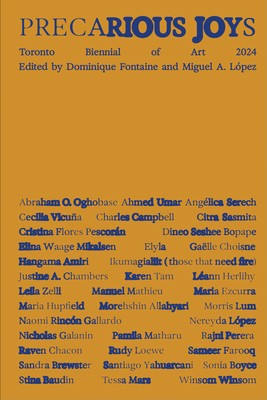
- We will send in 10–14 business days.
- Publisher: Goose Lane Editions
- ISBN-10: 1773104381
- ISBN-13: 9781773104386
- Format: 20.1 x 30.2 x 1.3 cm, minkšti viršeliai
- Language: English
- SAVE -10% with code: EXTRA
The Toronto Biennale 2024 (e-book) (used book) | bookbook.eu
Reviews
Description
This volume accompanies the 2024 edition of the Toronto Biennial of Art -- a city-wide exhibition that this year focuses on artists' responses to the impact of colonialism on everyday life. Featuring over 120 full-colour images of artwork -- including works by Ahmed Umar, Charles Campbell, Dineo Seshee Bopape, Maria Hupfield, Sonia Boyce, and Tessa Mars -- as well as a series of conversations between artists, curators, activists, educators, and cultural organizers, the book highlights the connections and common practices that appear across the art featured in the Biennial.
The works and conversations included in this celebration of the 2024 Toronto Biennial of Art address the wide-ranging effects of colonialism, tackling issues as diverse as environmental degradation, self-representation and belonging, queer futurity, and migrant diasporas. The result is a volume that emphasizes the importance of entering a collective dialogue at the intersection of art practices, social knowledge, and public action and serves as a meeting place of multiple vocabularies, geographies, and political communities.
EXTRA 10 % discount with code: EXTRA
The promotion ends in 23d.04:28:16
The discount code is valid when purchasing from 10 €. Discounts do not stack.
- Publisher: Goose Lane Editions
- ISBN-10: 1773104381
- ISBN-13: 9781773104386
- Format: 20.1 x 30.2 x 1.3 cm, minkšti viršeliai
- Language: English English
This volume accompanies the 2024 edition of the Toronto Biennial of Art -- a city-wide exhibition that this year focuses on artists' responses to the impact of colonialism on everyday life. Featuring over 120 full-colour images of artwork -- including works by Ahmed Umar, Charles Campbell, Dineo Seshee Bopape, Maria Hupfield, Sonia Boyce, and Tessa Mars -- as well as a series of conversations between artists, curators, activists, educators, and cultural organizers, the book highlights the connections and common practices that appear across the art featured in the Biennial.
The works and conversations included in this celebration of the 2024 Toronto Biennial of Art address the wide-ranging effects of colonialism, tackling issues as diverse as environmental degradation, self-representation and belonging, queer futurity, and migrant diasporas. The result is a volume that emphasizes the importance of entering a collective dialogue at the intersection of art practices, social knowledge, and public action and serves as a meeting place of multiple vocabularies, geographies, and political communities.


Reviews